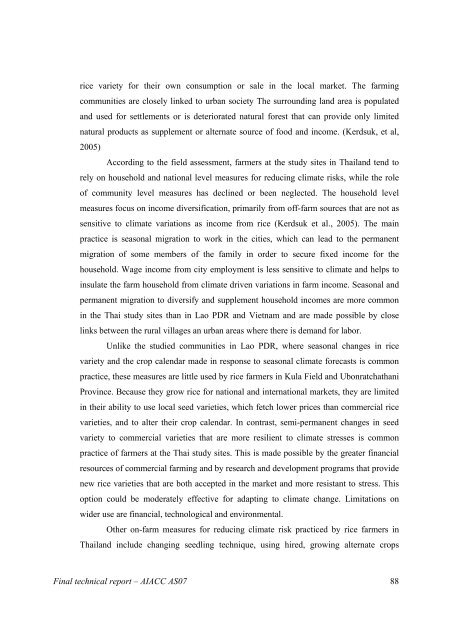Final Technical Report - weADAPT
Final Technical Report - weADAPT
Final Technical Report - weADAPT
- No tags were found...
Create successful ePaper yourself
Turn your PDF publications into a flip-book with our unique Google optimized e-Paper software.
ice variety for their own consumption or sale in the local market. The farming<br />
communities are closely linked to urban society The surrounding land area is populated<br />
and used for settlements or is deteriorated natural forest that can provide only limited<br />
natural products as supplement or alternate source of food and income. (Kerdsuk, et al,<br />
2005)<br />
According to the field assessment, farmers at the study sites in Thailand tend to<br />
rely on household and national level measures for reducing climate risks, while the role<br />
of community level measures has declined or been neglected. The household level<br />
measures focus on income diversification, primarily from off-farm sources that are not as<br />
sensitive to climate variations as income from rice (Kerdsuk et al., 2005). The main<br />
practice is seasonal migration to work in the cities, which can lead to the permanent<br />
migration of some members of the family in order to secure fixed income for the<br />
household. Wage income from city employment is less sensitive to climate and helps to<br />
insulate the farm household from climate driven variations in farm income. Seasonal and<br />
permanent migration to diversify and supplement household incomes are more common<br />
in the Thai study sites than in Lao PDR and Vietnam and are made possible by close<br />
links between the rural villages an urban areas where there is demand for labor.<br />
Unlike the studied communities in Lao PDR, where seasonal changes in rice<br />
variety and the crop calendar made in response to seasonal climate forecasts is common<br />
practice, these measures are little used by rice farmers in Kula Field and Ubonratchathani<br />
Province. Because they grow rice for national and international markets, they are limited<br />
in their ability to use local seed varieties, which fetch lower prices than commercial rice<br />
varieties, and to alter their crop calendar. In contrast, semi-permanent changes in seed<br />
variety to commercial varieties that are more resilient to climate stresses is common<br />
practice of farmers at the Thai study sites. This is made possible by the greater financial<br />
resources of commercial farming and by research and development programs that provide<br />
new rice varieties that are both accepted in the market and more resistant to stress. This<br />
option could be moderately effective for adapting to climate change. Limitations on<br />
wider use are financial, technological and environmental.<br />
Other on-farm measures for reducing climate risk practiced by rice farmers in<br />
Thailand include changing seedling technique, using hired, growing alternate crops<br />
<strong>Final</strong> technical report – AIACC AS07 88
















